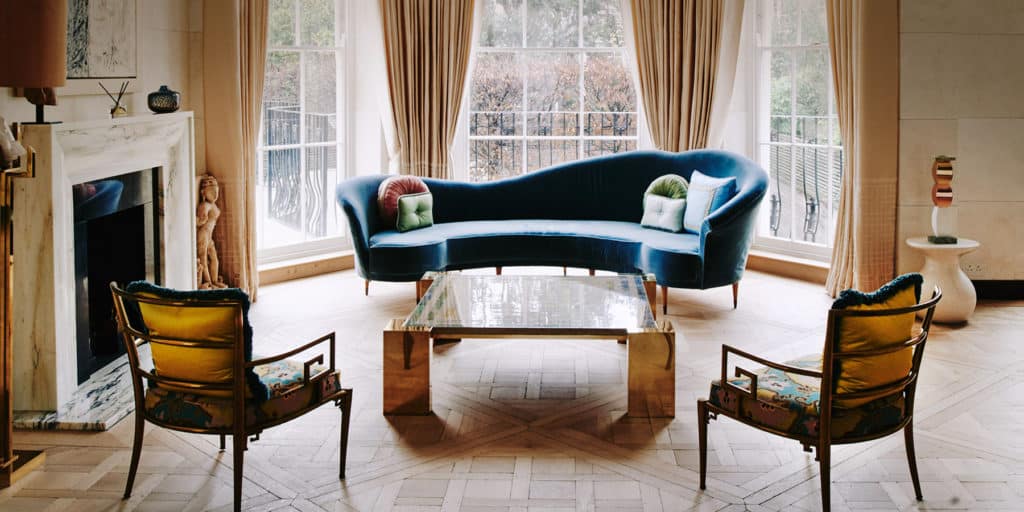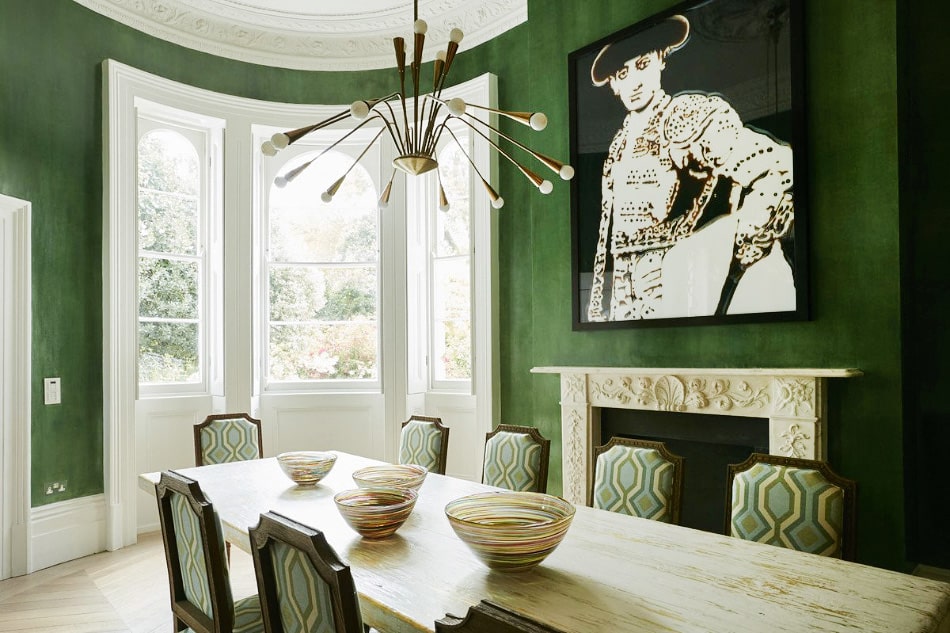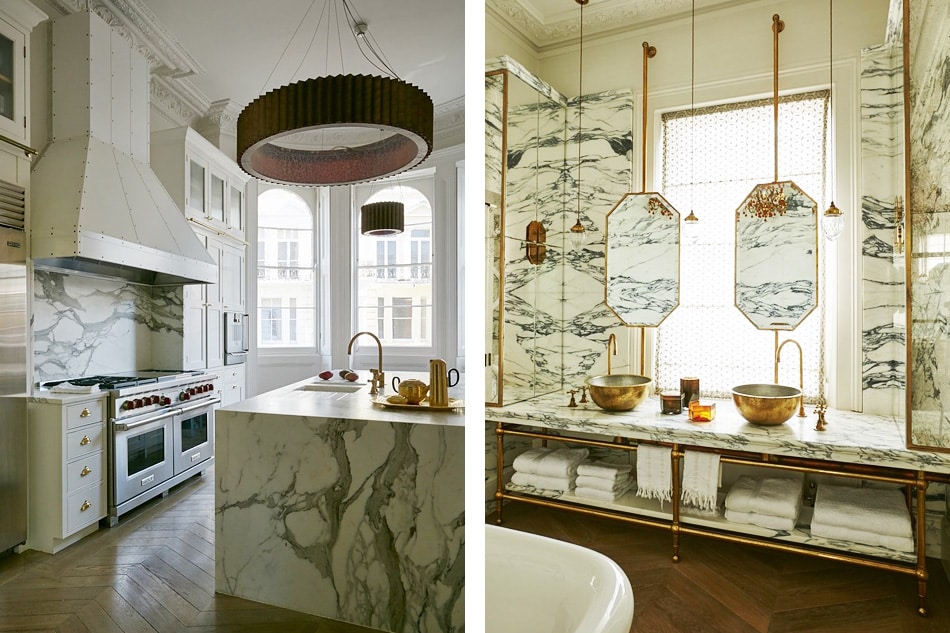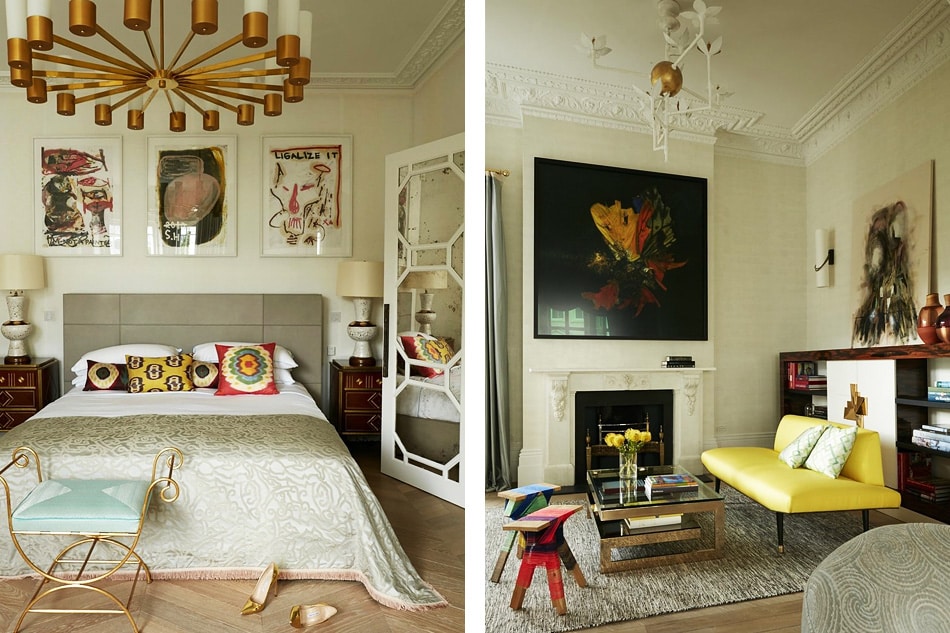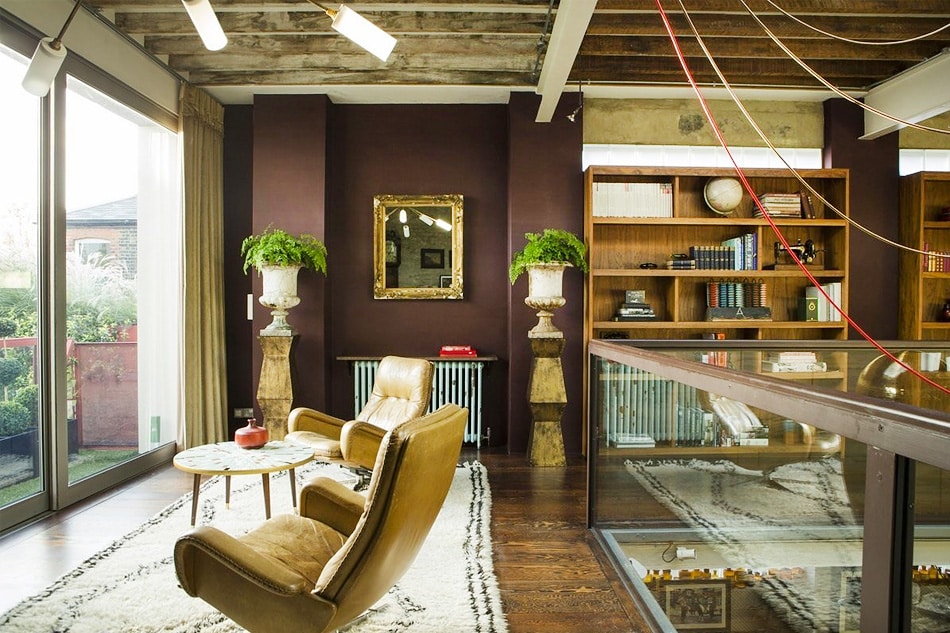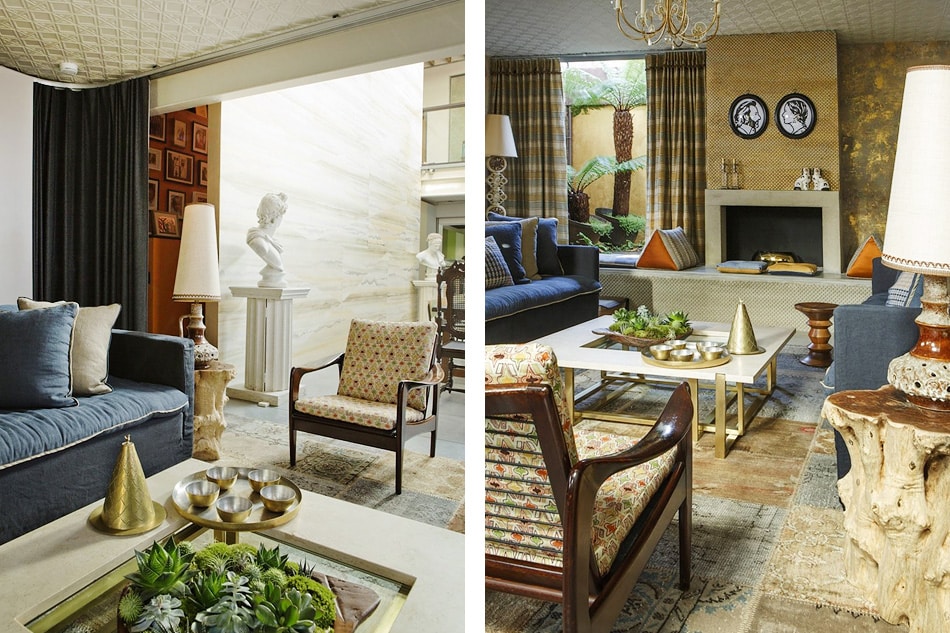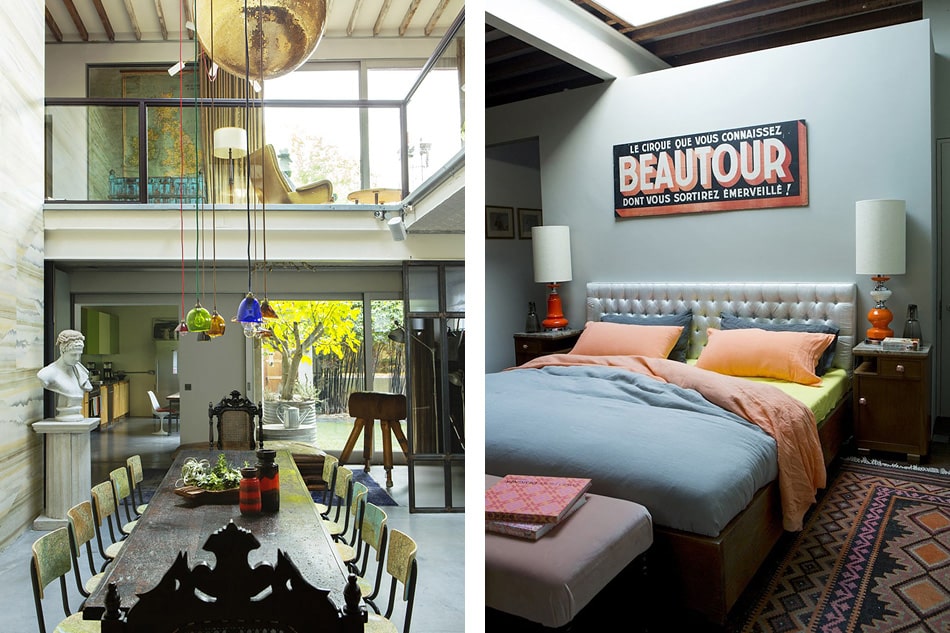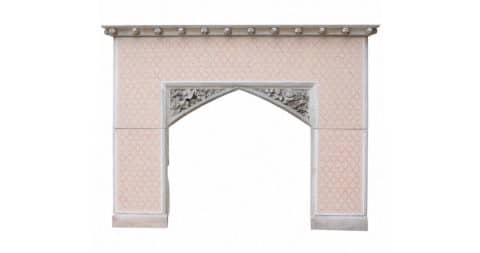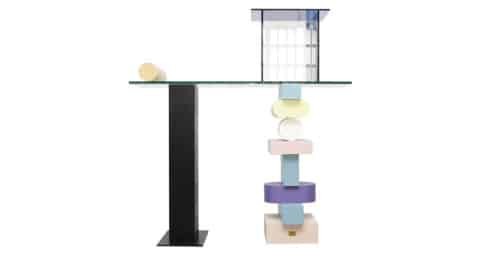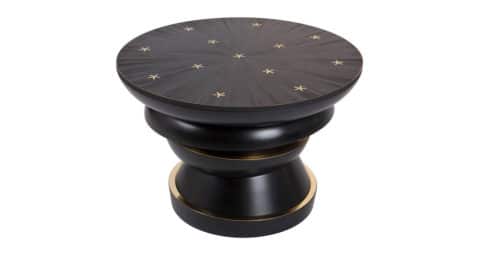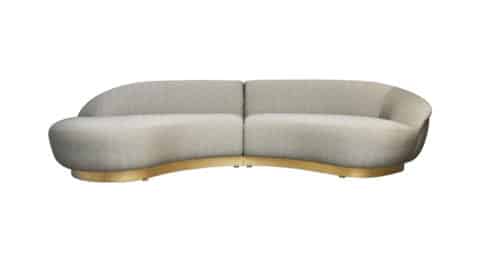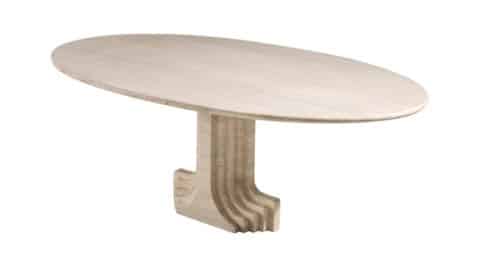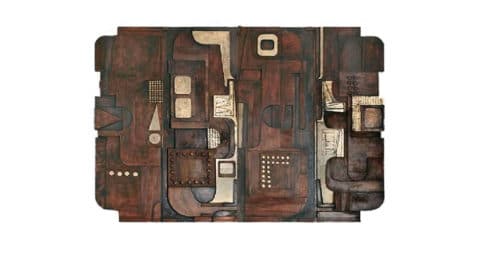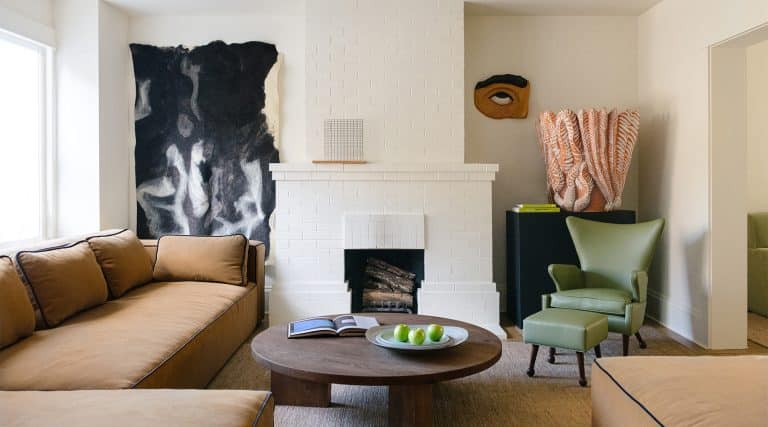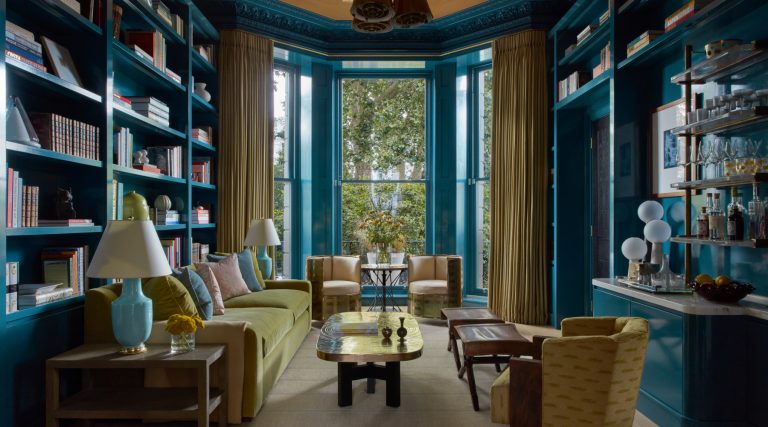
May 15, 2017Designers Scott Maddux and Jo leGleud teamed up to launch their London-based interior practice Maddux Creative in 2011 (portrait by Gabby Laurent). Top: For the living room of a townhouse in London’s Holland Park neighborhood, Maddux and leGleud took overall inspiration from the work of Jean-Michel Frank, furnishing it with an Ico Parisi sofa, a late-1970s Marcello Mioni cocktail table from Paul Marra Design and a pair of brass armchairs. Photo by Michael Sinclair
The London-based interior designer Scott Maddux is refreshingly upbeat. “He’s always smiling,” notes one of his clients, for whom he decorated a voluminous mid-Victorian house in the British capital. “He has a positive response to everything.”
“He’s infectiously enthusiastic and fun,” concurs Hatta Byng, the editor in chief of British House & Garden. To spend even a bit of time with him is to understand why: He peppers conversations with laughter, ending almost every sentence with a chortle if not an outright guffaw. And Maddux seems positively content with his lot. “It’s wonderful to be creating beauty,” he tells me over coffee at the Café de Flore in Paris. “What an amazing job!”
It was in 2011 that he founded his current firm, Maddux Creative, with his business partner, Jo leGleud, and in only a short time, they have risen to the zenith of British decorating. “I would say they are one of the stars of the London scene,” declares Byng. “There’s something really wow! about their work.” Says Tim Butcher, the creative director of the London-based wallpaper and fabric firm Fromental, for whom Maddux Creative just designed a new showroom at the Chelsea Harbour Design Centre: “They’re fun but not frivolous, bold and dramatic yet elegant,”
Their projects to date have ranged from homes in New York and the Cotswolds to residences in Switzerland and Saint-Tropez, and Elle Decor featured a house they designed in Holland Park on its September cover last year. In 2014, The World of Interiors devoted a six-page feature to just a Notting Hill bathroom they crafted. But what a bathroom it was — awash in arabescato marble, brass and mirrors.

The herringbone-floored living room of a townhouse in London’s Notting Hill features a curvaceous custom sofa directly commissioned from Vladimir Kagan, René Prou stools from Galerie André Hayat and a small sofa by Parisi from Ebury Trading Ltd. Photo by Michael Sinclair
Maddux and leGleud’s offices are in the southeast London district of Peckham, housed in an Edwardian former cricket-bat factory where their neighbors include an upholsterer and picture framer. The partners complement each other extremely well. They met two decades ago, after leGleud married one of Maddux’s friends. She had graduated with a degree in fine-art craft design from the Carlisle College of Art, in northwest England, and previously worked as a couture embroiderer. Today, leGleud has a dual role: She supervises the administrative side of things, and she also oversees soft-furnishing details, such as silk pompom wardrobe-door pulls, and sourcing artisans. (She is currently on the hunt for lace manufacturers in Scotland.) “I concentrate more on the architectural details and how everything flows. And when we get to the embellishments, Jo definitely excels at that — and somehow she also manages to make order from the chaos I’m creating,” Maddux explains, laughing.
Maddux was born in 1972 in a small town called Kingsport in eastern Tennessee. His parents divorced when he was four, and he was brought up by his mother, who was employed by a book manufacturer. “I’m still drawn to using books in my spaces,” he say, “and I love designing a library. I think it’s one of my favorite rooms to do.”
As a child, he would sketch architectural plans and futuristic apartments. “It was sort of Jetsons-inspired pod living,” he recalls. “I was quite a sci-fi nut as a kid.”
He enrolled in a liberal arts program at the University of Virginia but switched to the architecture school after one year. By the time he graduated, he was feeling burned-out. “It’s a pretty grueling education,” he states. “Lots of late nights. You’re quite alone in your work in many cases.” So, in 1994, he moved to London, drawn there by the British pop-music videos he had seen on MTV as a child by artists like Ultravox and David Bowie. “The Ashes to Ashes video haunted me. To me, pop music in Britain seemed very alternative.” For several years, he contented himself with odd jobs, working as a shop clerk in clothing stores, a waiter on canal boat cruises and, now and again, as a model. He also assisted with the restoration of several National Trust properties. “At one, I was actually shoveling pigeon shit from the eaves,” he relates. “It wasn’t all glamour!”
Then, in 1998, he was introduced by a friend to interior designers Hubert Zandberg and David Champion, then business partners, and he began doing furniture drawings for them. The following year, he was hired by the highly regarded London decorator Ann Boyd, who had previously served as European creative director for Ralph Lauren. “She’s an amazing woman,” he enthuses. “She’s tough on people but also super-fun and really generous.” It was in 2005 that Maddux started to branch out on his own, and he and leGleud now work alongside three employees.
He insists Maddux Creative doesn’t have a prescribed look, but when pressed, he describes its style as “multifaceted, colorful and considered.” Declares Byng: “Their interiors are brave and quite unexpected. They’re just slightly different.”
“I would say they are one of the stars of the London scene,” British House & Garden editor Hatta Byng says of Maddux and leGleud. “There’s something really wow! about their work.”
Common elements include splashes of bright color and textured walls, whether created using grasscloth wallpapers, as in a house they are currently completing in New York’s Hamptons, or a geometric plaster relief, deployed in the library of the Holland Park house. Maddux proclaims a love of mid-century Italian design by the likes of Giò Ponti and Carlo Mollino (“It has a frivolity”) and a passion for the paintings of 20th-century British artist Ben Nicholson, which influence the striking murals he often commissions. “He seems to inspire everything we do,” admits Maddux. “I like the layering, the overlapping, the intersection of shapes and volumes in Nicholson’s work.”

Back in the living room of the Holland Park home, a nook holds a French Art Deco games table surrounded by Kaare Klint chairs. A ceramic piece by Ettore Sottsass sits atop a ceramic taboret by Garouste and Bonetti. Photo by Michael Sinclair
Maddux and leGleud’s interiors always feature a happy mix of pieces from different eras. The Holland Park house, for instance, brings together a 1690s William and Mary chest with contemporary chandeliers by Johanna Grawunder and Hervé Van der Straeten. They also endow their spaces with a certain quirkiness. For a house in London’s Chelsea, Maddux took an 18th-century Flemish tapestry, had it expertly cut in half and refashioned it into a pair of curtains. In a factory conversion project in London’s Kensal Rise, he decorated the study with a vintage vaulting horse and leather gym mats.
Both he and leGleud, meanwhile, are enthusiastic advocates of contemporary craftsmanship. One of the artisans they work with regularly is the London-based decorative painter Isabelle Day. “She’s our secret weapon,” says Maddux. “She comes in and works her magic.”
Currently in the works are a weekend house on the Sussex coast in England, and a Victorian Gothic Revival mansion in Highgate, north London, in which they plan to incorporate ornate geometric borders on the floors, Arts & Crafts furniture and custom wallpapers inspired by the 19th century Aesthetic Movement. “We’ve had to really embrace Victoriana and high-Gothic detailing,” says Maddux.
Whatever the project, Maddux never fails to keep the process as enjoyable as possible. As he likes to say: “Design should be fun. I think you should realize you’re not saving lives.”
Scott Maddux’s Quick Picks on 1stdibs
